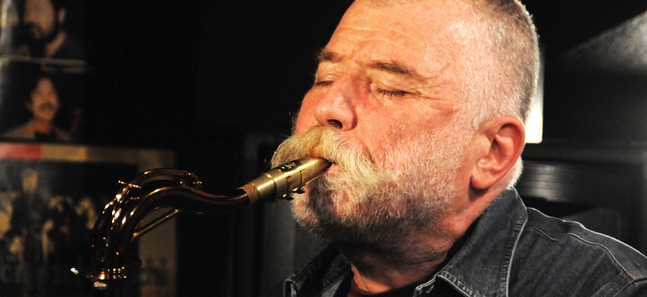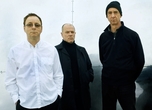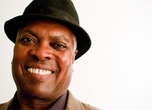Peter Brötzmann: the interview
The 70-year-old free-jazz titan reflects on a life of aesthetic extremity

Posted: Wed Oct 12 2011
One day in the mid-1980s, Peter Brötzmann came upon a dead crow lying in the road. Rather than recoil, the German saxophonist collected the carcass and slapped it onto the cover of a forthcoming record by his assaultive noise-jazz ensemble, Last Exit. “Why not use it?” says the 70-year-old, calling from his home in Wuppertal, when asked about the unfortunate bird. “That’s what you experience day by day.”
You couldn’t ask for a better summation of Brötzmann’s ultravisceral aesthetic. Grounded in visual and conceptual art, the saxophonist began channelling the tenor hysterics of John Coltrane, Albert Ayler and Pharoah Sanders; by the mid-’60s he had garnered a reputation as one of the most extreme horn players on the planet. After a series of 1966 Paris performances with free-jazz innovator Don Cherry, the trumpeter pegged Brötzmann with a pair of nicknames: Living Ball of Fire and Machine Gun, the latter becoming the title of an epochal 1968 LP by the saxist.
Though Brötzmann’s roaring-dragon style clearly referenced his US counterparts, his approach diverged in one crucial sense. American free jazz was all about elevated consciousness, expressed in album titles like Spiritual Unity and Interstellar Space, but Brötzmann gravitated toward more primal impulses, issuing LPs named Balls and Nipples. “I always was really standing with both feet on the soil,” explains the saxophonist. “At that time, we were a little bit tired of all these American record titles; they were much too esoteric. We had to fight every day. I know the guys in [the US] had to do the same, but the solution for us was not in some kind of other world – it was just here.”
For all its tough pragmatism, Brötzmann’s worldview shouldn’t be read as nihilistic. The saxophonist, who’s as good-natured in conversation as he is bullish onstage, is a community-builder at heart. Over the course of his four-decade career, he’s established himself as one of the international jazz scene’s foremost proponents of large-ensemble collaboration, uniting far-flung improvisers in colourful mosaics. The Machine Gun octet session was a summit meeting of European avant-garde future stars, like Dutch drummer and master absurdist Han Bennink (with whom Brötzmann has played ever since) and British sax sorcerer Evan Parker. Later projects roped in musicians from South Africa and Japan, and Brötzmann’s current signature band, the Chicago Tentet, teams Midwestern improvisers with their Scandinavian counterparts. (Two members of the Tentet, drummer Paal Nilssen-Love and cellist Fred Lonberg-Holm, accompany Brötzmann on his latest Japan tour.)
Brötzmann’s interest in jumbo-size groups offers a clue to his deep jazz roots, which stretch far beyond the ’60s avant-garde. As a young man, he witnessed a Wuppertal concert by New Orleans reed legend Sidney Bechet – Brötzmann remembers him as an “amazing tsunami to watch” – and he credits his love for volcanic saxophone shrieks to his experience performing in a distinctly old-school format. “When I was 14 or 15, I was playing in a kind of swing band,” Brötzmann recalls. “I had two or three trio numbers, and one of them was ‘I Got Rhythm,’ a very simple tune, which was good for me. And we had a good drummer in the band; he was a little Gene Krupa–style guy (Laughs). Then I learned that I like very much if it’s really steaming, if it’s really cooking. And I think in this time, because the horn I was playing was old and fucked-up, I did my first screams. I still like to do it.”
For all his sustained extremity, Brötzmann remains a highly interactive player: recent encounters with koto player Michiyo Yagi, for example, have yielded eerie modernist blues. The saxophonist clearly relishes the diversity of his output, and if listeners detect an element of coal-black comedy in some of his most imposing work – think of that poor dead crow – they’re far from mistaken. “There is a kind of hidden dark humour behind my things,” Brötzmann says. “It’s not always the screaming, not always the pain, not always the heavy blues. I mean, look at the blues: The blues is very funny sometimes. Humour maybe looks different here in Europe than in the States, but you need it to survive. I think it’s very useful.”
BrötzFest 2011, Oct 14-16, Pit Inn
This article originally appeared in Time Out New York. Click here for an unabridged Q&A with Peter Brötzmann
Tweets
- About Us |
- Work for Time Out |
- Send us info |
- Advertising |
- Mobile edition |
- Terms & Conditions |
- Privacy policy |
- Contact Us
Copyright © 2014 Time Out Tokyo














Add your comment